Assessment of the Clinical Effects of Aquatic-based Exercises in the Treatment of Children With Juvenile Dermatomyositis: A 2x2 Controlled-Crossover Trial
- PMID: 32637925
- PMCID: PMC7322310
- DOI: 10.5606/ArchRheumatol.2020.7548
Assessment of the Clinical Effects of Aquatic-based Exercises in the Treatment of Children With Juvenile Dermatomyositis: A 2x2 Controlled-Crossover Trial
Abstract
Objectives: This study aims to compare the effect of aquatic-based exercises (AQBEs) and land-based exercises (LBEs) on muscle strength, fatigue and quality of life (QoL), and skin disease activity in children with juvenile dermatomyositis (JDM).
Patients and methods: The design of the study was an assessor-blinded, controlled 2x2 crossover trial. Fourteen children (4 boys, 10 girls; mean age 11.7±2.2 years; range, 10 to 16 years) were evaluated. AQBEs and LBEs were applied through two treatment sequences as half of the children received AQBEs first while the second half received LBEs first. Isometric muscle strength, fatigue level and QoL (Pediatric Quality of Life Inventory Multidimensional Fatigue Scale [PedsQL-MFS]), and skin disease activity score (DASskin) were measured at four occasions for each treatment sequence.
Results: The AQBEs had significant superiority over LBEs with improved hip flexors' strength (p=0.007) and hip abductors' strength (p=0.001), while both types of treatment had the same effect in increasing strength of shoulder flexors and abductors (p<0.05). AQBEs improved PedsQL-MFS, and DASskin significantly more than LBEs (p<0.001). For all outcome measures, there was no significant difference in the treatment sequence the children received first.
Conclusion: Supervised AQBEs are more effective in improving muscle strength, fatigue and QoL, and skin disease activity than LBEs in children with JDM. Furthermore, the treatment sequence had no significant effect on measured variables.
Keywords: Aquatic-based exercises; juvenile dermatomyositis; land-based exercises; skin disease activity.
Copyright © 2020, Turkish League Against Rheumatism.
Conflict of interest statement
Conflict of Interest: The authors declared no conflicts of interest with respect to the authorship and/or publication of this article.
Figures

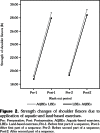
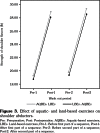

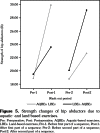
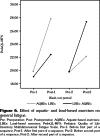
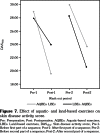
References
-
- McCann LJ, Juggins AD, Maillard SM, Wedderburn LR, Davidson JE, Murray KJ, et al. The Juvenile Dermatomyositis National Registry and Repository (UK and Ireland)--clinical characteristics of children recruited within the first 5 yr. Rheumatology (Oxford) 2006;45:1255–1260. - PubMed
-
- Ravelli A, Trail L, Ferrari C, Ruperto N, Pistorio A, Pilkington C, et al. Long-term outcome and prognostic factors of juvenile dermatomyositis: a multinational, multicenter study of 490 patients. Arthritis Care Res (Hoboken) 2010;62:63–72. - PubMed
-
- Mendez EP, Lipton R, Ramsey-Goldman R, Roettcher P, Bowyer S, Dyer A, et al. US incidence of juvenile dermatomyositis, 1995-1998: results from the National Institute of Arthritis and Musculoskeletal and Skin Diseases Registry. Arthritis Rheum. 2003;49:300–305. - PubMed
-
- Symmons DP, Sills JA, Davis SM. The incidence of juvenile dermatomyositis: results from a nation-wide study. Br J Rheumatol. 1995;34:732–736. - PubMed
LinkOut - more resources
Full Text Sources
